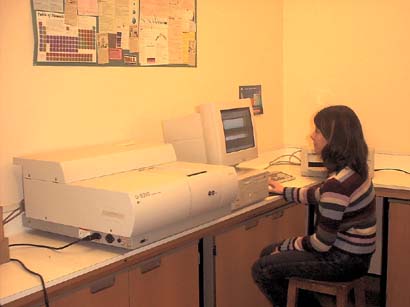The UV-visible spectrometer
A spectrometer detects when UV-visible radiation is absorbed by a sample and plots this on a graph.

The source of radiation for the visible region is a tungsten lamp and for the ultraviolet region, a deuterium discharge lamp.
The monochromator separates the radiation into its constituent wavelengths by it passing through a prism. The angle of the prism is altered to direct different wavelengths onto the sample. These are then passed through the sample individually and when transmittance is reduced, this is detected and a peak recorded on the graph.
The value where absorption occurs is known as lmax. We know typical values of lmax for different functional groups so we can then go about deducing what a sample consists of. For example, if we saw absorption as lmax = 177, we could deduce that an alkene was present. There is a table of the most common values here.
This is what a UV-visible spectrometer looks like in the lab:


